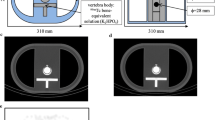Abstract
Objective
As metastasis of prostate carcinoma occurs in approximately 80 % of terminal prostate carcinoma patients, the prognostic value of the prediction of prostate carcinoma by bone scintigraphy is important. We compared the automated and semi-automated bone scan index (BSI) system with extent of disease (EOD) grade if there is a possibility to substitute for EOD grading.
Materials and methods
We evaluated the bone scintigraphic images of 158 prostate carcinoma patients (mean age, 69.2 years old; range 50–97). Bone scans were obtained approximately 3 h after the intravenous injection of 740 MBq technetium-99 m-methylene diphosphonate. EOD grade was evaluated by 2 experienced radiologists using bone scintigraphy, magnetic resonance imaging, and computed tomography. We calculated the BSI using the Bonenavi® system (Fujifilm RI Pharma Co., Ltd.), utilizing data from a Japanese database. The semi-automated BSI of the patients was obtained by modifying the automated BSI independently by 3 radiologists (referred to as “observers” in this study) with 25, 10, and 4 years of experience. We then compared the EOD with the corresponding 4 independent BSIs for each patient. We used the Steel–Dwass test for multiple comparisons of the BSI among different EOD groups of patients. We analyzed the receiver-operating characteristics (ROC) curve to determine the cutoff values of sensitivity and specificity, which were both set at 95 %.
Results
There were significant correlations observed among the mean EOD and BSI scores as determined using the Bonenavi® system for every patient group for all observers and the automated method. There was also a statistically significant difference in the mean BSI among all EOD groups (grades 0, 1, or 2–4) for all observers and the automated method. Each ROC curve showed an ideal shape and was within the optimal cutoff range.
Conclusion
On the basis of the present results, BSI as calculated using the Bonenavi® system significantly correlated with EOD. Sensitivity and specificity as measured by the fully automated method were lower than those of semi-automated BSI with modification by radiologists. Therefore, semi-automated BSI is considered to have the possibility to substitute for EOD grading to predict the survival of prostate carcinoma patients with bone metastases, with only slight interobserver variation.



Similar content being viewed by others
References
Namiki M, Akaza H, Lee SE, Song JM, Umbas R, Zhou L, et al. Prostate Cancer Working Group report. Jpn J Clin Oncol. 2010;40(Suppl 1):i70–5.
Nakata S, Ohtake N, Yamanaka H. Epidemiology of prostate cancer in Japan. Nihon Rinsho. 2011;69 Suppl 5:181–186 (in Japanese).
Knudson G, Grinis G, Lopez-Majano V, Sansi P, Targonski P, Rubenstein M, et al. Bone scan as a stratification variable in advanced prostate cancer. Cancer. 1991;68:316–20.
Amico S, Liehn JC, Desoize B, Larbre H, Deltour G, Valeyre J. Comparison of phosphatase isoenzymes PAP and PSA with bone scan in prostate carcinoma. J Clin Nucl Med. 1991;13:643–8.
Soloway MS, Hardeman SW, Hickey D, Raymond J, Todd B, Soloway S, et al. Stratification of patients with metastatic prostate cancer based on extent of disease on initial bone scan. Cancer. 1988;61:195–202.
Erdi YE, Humm JL, Imbriaco M, Yeung H, Larson SM. Quantitative bone metastases analysis based on image segmentation. J Nucl Med. 1997;38:1401–6.
Imbriaco M, Larson SM, Yeung HW, Mawlawi OR, Erdi Y, Venkatraman ES, et al. A new parameter for measuring metastatic bone involvement by prostate cancer: the bone scan index. Clin Cancer Res. 1998;4:1765–72.
International Commission on Radiation Protection. Publication 23: report of the task group on reference man. New York: Pergamon Press; 1992.
Sadik M, Jakobsson D, Olofsson F, Ohlsson M, Suukula M, Edenbrandt L. A new computer-based decision-support system for the interpretation of bone scans. Nucl Med Commun. 2006;27:417–23.
Sadik M, Suurkula M, Höglund P, Järund A, Edenbrandt L. Quality of planar whole-body bone scan interpretations—a nationwide survey. Eur J Nucl Med Mol Imaging. 2008;35:1464–72.
Sadik M, Hamadeh I, Nordblom P, Suurkula M, Höglund P, Ohlsson M, Edenbrandt L. Computer-assisted interpretation of planar whole-body bone scans. J Nucl Med. 2008;49:1958–65.
Sadik M, Suurkula M, Höglund P, Järund A, Edenbrandt L. Improved classifications of planar whole-body bone scans using a computer-assisted diagnosis system: a multicenter, multiple-reader, multiple-case study. J Nucl Med. 2009;50:368–75.
Acknowledgments
We are indebted to Mr. Roderick J. Turner, Associate Professor Edward F. Barroga and Professor J. Patrick Barron, Chairman of the Department of International Medical Communications of Tokyo Medical University, for their editorial review of the English manuscript.
Author information
Authors and Affiliations
Corresponding author
Rights and permissions
About this article
Cite this article
Takahashi, Y., Yoshimura, M., Suzuki, K. et al. Assessment of bone scans in advanced prostate carcinoma using fully automated and semi-automated bone scan index methods. Ann Nucl Med 26, 586–593 (2012). https://doi.org/10.1007/s12149-012-0617-0
Received:
Accepted:
Published:
Issue Date:
DOI: https://doi.org/10.1007/s12149-012-0617-0




